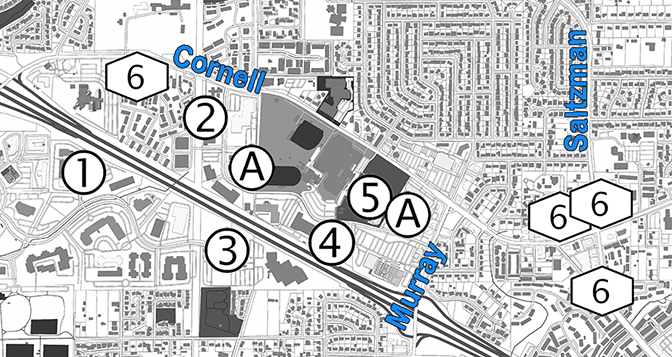How clean is our air?

by Greg Bourget, Executive Director, Portland Clean Air
Portland Clean Air is a nonprofit that has been working for seven years to study and promote public understanding of government agency industrial air pollution data, and advocate for prevention. We asked them to give us a snapshot of the current situation in the Cedar Mill area, along with some ways to take action if you are concerned.
Portland Clean Air’s ranking of the Washington County industries most dangerous to human health, according to the DEQ Level I Screening, can be found here: portlandcleanair.org/files/HAW%20ranking.pdf.

This GIS map of EPA 2014 National Air Toxics Assessment data, released to the public by the EPA August 2018, shows on-road diesel particulate modeled by EPA distributed over roads using ODOT 24-hour truck counts, modeled by Portland Clean Air. GIS Map by Michael Egge, PhD Student Portland State University & Andrea Richards, Graduate Student Portland State University. Data compilation by Greg Bourget & Alissa Leavitt. All Data online at portlandcleanair.org
The Cedar Mill area has no heavy industry so is blank on that map. The map showing every industry releasing toxic chemicals to the air, including in Cedar Mill, is on the Hillsboro Air & Water website.
Diesel emissions
Oregon Department of Environmental Quality (DEQ) doesn’t use human health as a factor in the regulation of industrial air pollution. Governor Brown’s Cleaner Air Oregon program has vastly improved reporting but this hasn’t resulted in improved health-based regulation yet. Because of this problem, Portland Clean Air filed information requests and obtained the data from eight agencies that regulate Portland industry. We use statistics software, GIS mapping, Google mapping, computer programming, and web design to make this data understandable to everyone.
Currently Multnomah County is ranked by the EPA in the worst 1.3% of counties in the US for diesel particulate, the most dangerous airborne carcinogen according to State of California risk assessments. When used, diesel particulate filters capture 90% of a truck’s particulate exhaust. By 2015 virtually all California diesel trucks had a filter, as required by law. In the three-county Portland area, three-fourths of commercial trucks do not have a filter, according to ODOT and DMV records.
[Ed. Note: I was told that the reason Oregon doesn’t have requirements for diesel filters was related to our lack of campaign funding regulations. We just voted to begin regulating that, so hopefully we’ll get better health protection from future legislatures.]
In 2018, ODOT counted as many as 285 commercial trucks in a 24-hour period on Sunset Highway. This is a relatively high truck count, however areas of Inner NE Portland experience truck rates up to six times higher. Portland Clean Air is helping people install and interpret $50 wifi sensors that can track this particulate. We also loan $300 particulate sensors with GPS that can be biked around the neighborhood. Unusually heavy exposure results in black or dark grey buildup on doors, windows, and porches. According to NASA, any indoor HEPA air filter can remove all woodsmoke and diesel particulate. Many low-income people live in areas of higher exposure, but we don’t know of any program to help them acquire filters.
Dry cleaning, (6 in a hexagon symbol)
This symbol is a DEQ Air Contaminant Discharge Permit (ACDP) for a dry cleaner using Tetrachloroethylene, also known perchloroethylene or “perc.” After looking at DEQ dry cleaner records, it appeared they each use and emit approximately one 55 gallon drum per year of this chemical. The EPA reports that health effects from high-level inhalation exposure to humans include irritation of the upper respiratory tract and eyes, neurological damage, adverse effects in the kidney, liver, immune system and hematologic system, and on reproduction and development. Studies of people exposed to perc in the workplace have found associations with several types of cancer. Numerous dry cleaners in the Portland area do not use perc for this reason.

each symbol represents.
Auto body painting (A in a circle symbol)
Living by an auto body painter often means experiencing a strong VOC odor. Industrial solvents at this concentration are not a significant danger to human health but can pose enough of a significant nuisance to warrant a control device such as a thermal oxidizer. Such a device can remove 99% of VOCs from the paint booth smokestack before they go airborne.
Toxic industrial chemical use (1-5 in a circle symbols)
These are facilities in the Oregon State Fire Marshall’s Hazardous Substance Information System (HSIS) for onsite chemical storage data for each industry. We have removed most non-hazardous materials and all chemicals coded by North American Industrial Classification System denoting chemicals warehoused or for retail, thus, not being used onsite. To view onsite chemicals in use at these facilities, go to the map at the top of portlandcleanair.org, click on the symbol, and click on the link that appears on the sidebar at the left of the page. None of these industries are large enough to report to DEQ, so if chemical emissions were a concern, it would probably only affect neighbors living within a block or two.
Hillsboro Airport
The Hillsboro Airport is the single largest industrial emitter of airborne lead in Oregon according to the EPA. The EPA National Emissions Inventory (NEI) released in February 2018 reported that the Hillsboro Airport releases 1,211 pounds of lead annually into the air. Of all the foundries, lead smelters, steel mills, battery manufacturers, airports, mines, chemical plants, and military bases in the United States, Hillsboro Airport ranks 65th worst out of 35,804 sources of airborne industrial lead pollution watched by the EPA. For more info go here: portlandcleanair.org/files/HAWAirportFinal.pdf
Get involved
Portland Clean Air works with 43 Portland Neighborhood Association boards, 14 churches and synagogues, three coalitions, and six other local groups to negotiate directly with the most dangerous industrial air polluters. They are working with Washington County Citizen Action Network (WC CAN) and Hillsboro Air & Water to bring awareness and action to the Tualatin Valley.
For questions, how to volunteer, and for new organizations who want to participate, contact greg@portlandcleanair.org.





